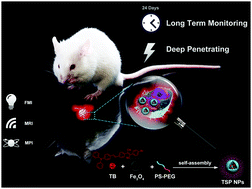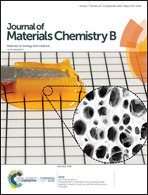High-efficiency fluorescent and magnetic multimodal probe for long-term monitoring and deep penetration imaging of tumors†
Abstract
High-quality multimodal imaging requires exogenous contrast agents with high sensitivity, spatial–temporal resolution, and high penetration depth for the accurate diagnosis and surveillance of cancer. Herein, we design a highly efficient fluorescent and magnetic multimodal probe by doping fluorescent molecule 2-(4-bromophenyl)-3-(4-(4-(diphenylamino)styryl)phenyl)fumaronitrile (TB) with near-infrared (NIR) fluorescent emission (714 nm) and superparamagnetic iron oxide (SPIO) into a polystyrene-polyethylene glycol (PS-PEG) matrix to form TB/SPIO@PS-PEG nanoparticles (TSP NPs). The as-prepared TSP NPs exhibit red aggregation-induced emission (AIE) with a maximum wavelength at 655 nm and high fluorescence quantum yield (QY) of 14.6%, facilitating the improvement of sensitivity and signal-to-background ratio for fluorescence molecular imaging (FMI). Phase behavior investigation of the TB/SPIO@PS-PEG probe system by Flory–Huggins lattice theory elucidates the highly efficient fluorescence of the multimodal probe, originating from the poor miscibility between TB and SPIO. Meanwhile, the TSP NPs possess good superparamagnetism and relaxivity and can thus be used as appropriate magnetic contrast agents for magnetic resonance imaging (MRI) and magnetic particle imaging (MPI). In addition, the good biocompatibility and photostability of the TSP NPs make them suitable for long-term monitoring. In vivo fluorescence imaging results indicate that the TSP NPs can facilitate monitoring of subcutaneous tumor growth for more than 24 days in a real-time manner. Multimodal imaging consisting of FMI, MRI, and MPI reveals that TSP NPs can monitor a liver tumor in situ with almost unlimited depth in tissues and high temporal–spatial resolution. As a multimodal probe, the TSP NPs manifest obvious synergistic advantages of long-term monitoring and high penetration depth and hold great prospects in tumor imaging.



 Please wait while we load your content...
Please wait while we load your content...